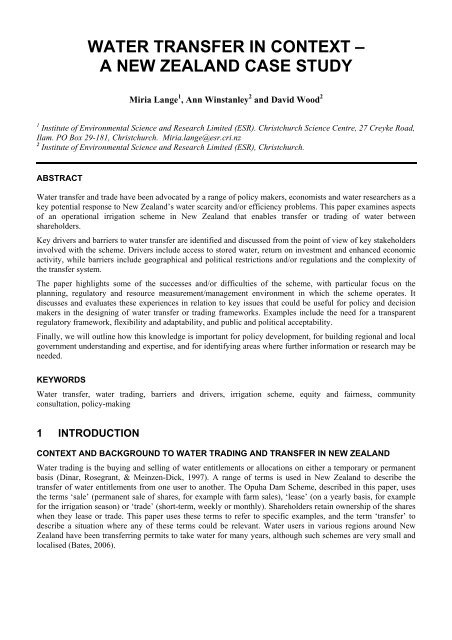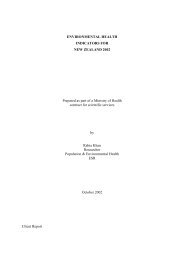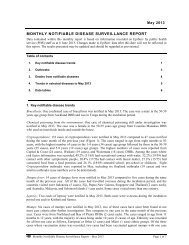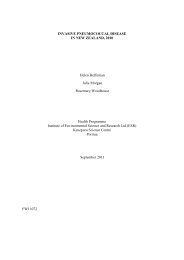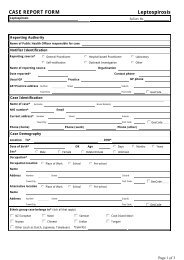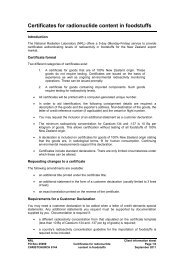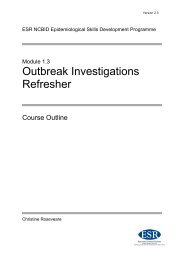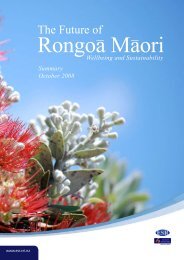Water Transfer in Context â A New Zealand Case Study
Water Transfer in Context â A New Zealand Case Study
Water Transfer in Context â A New Zealand Case Study
You also want an ePaper? Increase the reach of your titles
YUMPU automatically turns print PDFs into web optimized ePapers that Google loves.
eal use out of it <strong>in</strong> the future”. Information on the number and type of transfers that have taken place isunavailable but there is strong anecdotal evidence that people have transferred water. Comparison of statistical<strong>in</strong>formation on transfers with <strong>in</strong>formation on the hydrology and climatic conditions of the transfer period will beuseful for future research and decision-mak<strong>in</strong>g.Interviews with farmers and an iwi representative took place <strong>in</strong> and around Fairlie and Timaru, Canterburybetween May and October 2006. These farmers were from various parts of the catchment – above the dam,below the dam and those with no direct supply, as it appeared that these farmers had differential access to watereven though all held shares (from an <strong>in</strong>itial <strong>in</strong>terview with the chair of SCFIS). Background to the Opuha Damscheme and the methods for water transfer were obta<strong>in</strong>ed from a director of the scheme, the account<strong>in</strong>g firmresponsible for the adm<strong>in</strong>istration of the scheme (Hubbard Churcher and Co), and staff from EnvironmentCanterbury. The aim of the research was to ga<strong>in</strong> a greater understand<strong>in</strong>g of some of the key issues <strong>in</strong>volved withwater transfer <strong>in</strong> the Opuha scheme through discussions with people from a variety of stakeholder positions.2 FACTORS IMPACTING ON WATER TRANSFER2.1 FACTORS THAT ENABLED THE SCHEME TO GET UP AND RUNNINGThe Opuha Dam scheme has, as mentioned above, been hailed as a success, with farmers and the communityreceiv<strong>in</strong>g benefits. “It’s a w<strong>in</strong>-w<strong>in</strong> situation because there were no losers – everyone ga<strong>in</strong>ed. It is affordable tofarmers” (farmer below dam). “Storage was our community’s solution to achieve susta<strong>in</strong>able management of ourlocal resources while simultaneously <strong>in</strong>creas<strong>in</strong>g farm productivity and process<strong>in</strong>g opportunities on a reliablebasis” (Chair of SCFIS). There are various process, technical and economic factors that enabled the Opuhascheme to work well:2.1.1 PROCESSESThe success of the scheme has, <strong>in</strong> part, been made feasible by the partnerships established between irrigationcompanies, the power company Alp<strong>in</strong>e Energy, and the Timaru and MacKenzie District Councils. Alp<strong>in</strong>e Energyprovided the Opuha Dam Company with 50% of the f<strong>in</strong>ance, and generates about 10% of South Canterbury’senergy requirements as a consequence of releases for irrigation (Chair of SCFIS). The Timaru and MacKenzieDistrict Councils are also <strong>in</strong>volved as owners of equity <strong>in</strong>terest <strong>in</strong> Alp<strong>in</strong>e Energy Ltd. Timaru city is providedwith a guaranteed <strong>in</strong>dustrial and residential water supply.A variety of op<strong>in</strong>ions were expressed about the processes <strong>in</strong>volved <strong>in</strong> sett<strong>in</strong>g up the Opuha Dam scheme. Somefarmers stated that they were happy with the process used to <strong>in</strong>form and update them of developments andprogress. There were many public meet<strong>in</strong>gs and much discussion, and the directors put a lot of effort <strong>in</strong>todiscuss<strong>in</strong>g the scheme with farmers. The directors of the scheme believe they were aware that there would be arange of issues and of the importance of <strong>in</strong>volv<strong>in</strong>g the community. “It was a South Canterbury th<strong>in</strong>g, and wecerta<strong>in</strong>ly were m<strong>in</strong>dful of and had to respect the real concerns of the community” (Chair of SCFIS). However,there are also those who were unhappy with the process. “Not many ask your op<strong>in</strong>ions, most are us<strong>in</strong>gjustifications as to why it [water] needs to go there” (farmer above dam). Another farmer (below dam) expla<strong>in</strong>edthat he felt ‘black-mailed’ <strong>in</strong>to buy<strong>in</strong>g shares <strong>in</strong> the scheme. One of the directors spoke of the importance ofconv<strong>in</strong>c<strong>in</strong>g everybody of the benefits of the scheme. Overall, it seems that the processes used were satisfactoryand acceptable to most shareholders.2.1.2 TECHNICAL AND CONSENT ISSUESA key enabl<strong>in</strong>g factor has been the fact that the Opuha scheme has been able to enhance river flows as well asuse water for irrigation. The scheme utilises a m<strong>in</strong>imum flow regime <strong>in</strong> an attempt to limit negativeenvironmental impacts. M<strong>in</strong>imum flows for surface water are set to protect environmental factors such as fishhabitats and natural character and to ensure adequate provision of water for recreational activities (Counsell &Evans, 2005). “So we’re not there to flog the whole th<strong>in</strong>g, we’re there to look at environmental and recreationalbenefits too” (Chair of SCFIS).2.1.3 ECONOMIC OUTCOMESReliability of supply is a key issue for farmers. The scheme has provided a greater reliability of supply of waterfor farmers, some of whom have experienced up to 50% <strong>in</strong>creases <strong>in</strong> yield as a result of irrigation (farmer
<strong>in</strong>terviews). The scheme provides water to irrigate 16,000 ha (25 ml/ha/week) for the irrigation period betweenSeptember-April. Increased reliability of supply for farmers <strong>in</strong> turn provides more certa<strong>in</strong>ty for farm<strong>in</strong>g<strong>in</strong>dustries. “Economic activity <strong>in</strong> South Canterbury has never been greater, and all the players and the various<strong>in</strong>dustries are absolutely happy to know that we’ll get production every year” (Chair of SCFIS). A recent report(Harris et al., 2006) shows that there is $7.7 million per year per thousand hectares of irrigation <strong>in</strong> extraproductivity on farms and that irrigation associated with the Opuha has generated an additional 145 on-farm fulltimejobs. These economic outcomes can help to facilitate acceptability of the scheme amongst the community,and provide clear benefits for the farm<strong>in</strong>g sector.SUMMARYAll of these factors have contributed to the development and success of the Opuha scheme. The potential abilityfor farmers to transfer water is one important component of the scheme. The follow<strong>in</strong>g section describes some ofthe drivers and barriers to water transfer (see Table 1) and the subsequent discussion evaluates these barriers anddrivers <strong>in</strong> relation to key issues identified <strong>in</strong> the literature, highlight<strong>in</strong>g areas that may be useful for policydevelopment and for build<strong>in</strong>g regional and local government understand<strong>in</strong>g and expertise. We have attempted toseparate the drivers and barriers <strong>in</strong> order to provide a clear picture of some of the difficulties and/or successfulfactors. It should be noted that these may change with time and to some extent may be both drivers and barriersfor different stakeholders at different times.Table 1: Drivers and Barriers to <strong>Water</strong> <strong>Transfer</strong> <strong>in</strong> the Opuha SchemeDrivers to <strong>Water</strong> <strong>Transfer</strong> <strong>in</strong> the Opuha Scheme- Access to stored water, and know<strong>in</strong>g howmuch water has been used- Know<strong>in</strong>g the economic value of water- Return on <strong>in</strong>vestment- Enhanced economic activity- Changes to river management regimes- A simple adm<strong>in</strong>istration system- A self-polic<strong>in</strong>g systemBarriers to <strong>Water</strong> <strong>Transfer</strong> <strong>in</strong> the Opuha Scheme- <strong>Transfer</strong> could result <strong>in</strong> loss of access to water- Geographical restrictions- Regional government regulations- Belief that water transfer is unacceptable- Complex transfer system- Equity issues – not all have access to shares orto water3 DRIVERS FOR WATER TRANSFER IN THE OPUHA SCHEMEDiscussion of the drivers for water transfer <strong>in</strong>volves an exam<strong>in</strong>ation of the motives for transferr<strong>in</strong>g waterpermits. There are a variety of reasons why farmers might choose to sell, lease or trade water with<strong>in</strong> the Opuhascheme;
3.1 ACCESS TO STORED WATER, AND KNOWING HOW MUCH WATER HAS BEENUSEDOne of the key factors that enables water transfer to take place is access to stored water. This provides a degreeof certa<strong>in</strong>ty for farmers. “Why we can do this [transfer water] is because we’ve got an actual supply to negotiatewith. We can trade because we know what we’ve got and we know its there” (Chair of SCFIS). One condition ofthe Opuha scheme consent is that every shareholder’s abstractions must be cont<strong>in</strong>uously monitored. Eachshareholder has a flow meter with a data logger to cont<strong>in</strong>uously record the flow rate aga<strong>in</strong>st time of use, therebydeterm<strong>in</strong><strong>in</strong>g the volume of water used. Access to this <strong>in</strong>formation (the data is supplied by Hubbard Churcher andCo on a daily basis) shows shareholders exactly how much water they have used and how much of theirallocation is left. This enables farmers to decide whether they have water available for trade or lease, or whetherthey require access to more water. This <strong>in</strong>formation provides real <strong>in</strong>centives to trade or lease shares <strong>in</strong> the Opuhascheme. As noted above, one SCFIS share irrigates four hectares, provid<strong>in</strong>g 1000 cubic metres per week for theirrigation season. The total volume per irrigation season is 22,500 cubic metres per share. The flow rate is 1.6534litres/second for 1 SCFIS share.3.2 KNOWING THE ECONOMIC VALUE OF WATER<strong>Water</strong> users need to know the value of their water rights <strong>in</strong> order to make trad<strong>in</strong>g decisions. Ascrib<strong>in</strong>g economicvalues to water is a difficult and contentious issue, and numerous approaches exist for valu<strong>in</strong>g a water right,<strong>in</strong>clud<strong>in</strong>g, as listed by Counsell and Evans (2005), the sales comparison approach (where the value of a waterright is determ<strong>in</strong>ed by the price that similar water rights sell at), the land differentials approach (based on acomparison of land sales with and without water rights attached), and the <strong>in</strong>come capitalisation approach (whichcalculates the present value of the stream of net benefits that the water right generates over time). In the Opuhascheme, shareholders are able to <strong>in</strong>formally use a variety of these methods to ga<strong>in</strong> an understand<strong>in</strong>g of theeconomic value of water. For example, they have experienced an <strong>in</strong>crease <strong>in</strong> the market value of their shares,they have seen the <strong>in</strong>crease <strong>in</strong> land values <strong>in</strong> the district for properties with access to water, they are aware of theprices other shareholders are buy<strong>in</strong>g and sell<strong>in</strong>g at, and their net benefits <strong>in</strong> terms of on-farm production canclearly be seen. Hav<strong>in</strong>g an understand<strong>in</strong>g of the economic value of water enables shareholders <strong>in</strong> the scheme toclearly see the use value of water; the benefit received from direct or <strong>in</strong>direct use of water. This <strong>in</strong>formation canprovide an <strong>in</strong>centive to trade or transfer water.3.3 RETURN ON INVESTMENTThe construction of the water storage facility has <strong>in</strong>volved considerable <strong>in</strong>vestment by shareholders <strong>in</strong> thescheme. This <strong>in</strong>vestment provides a monetary value for water, and trad<strong>in</strong>g or transferr<strong>in</strong>g water a farmer does notneed clearly provides a return on this <strong>in</strong>vestment. “Now there wouldn’t be people who would want to be withouttheir shares. They have become a very valuable resource. I don’t th<strong>in</strong>k anyone will regret they have shares. It’s agood <strong>in</strong>vestment. If I had the opportunity aga<strong>in</strong>, I’d most likely buy a few more shares” (farmer with no directsupply).3.4 ENHANCED ECONOMIC ACTIVITYMany farmers <strong>in</strong> the scheme have achieved significant <strong>in</strong>creases <strong>in</strong> yield with the availability of a more reliablesource of water for irrigation. Be<strong>in</strong>g able to transfer water means that those who require greater access to waterat certa<strong>in</strong> times of the year for example, are more likely to be able to obta<strong>in</strong> this water. On the Levels Pla<strong>in</strong> forexample, one farmer expla<strong>in</strong>ed that they would not have been able to grow potatoes and onions <strong>in</strong> the areawithout irrigation. “We couldn’t grow potatoes here without the Opuha Dam. Just straight as” (Farmer belowdam). Sp<strong>in</strong>-offs from enhanced production of these crops <strong>in</strong>clude process<strong>in</strong>g factories <strong>in</strong> Timaru and cont<strong>in</strong>u<strong>in</strong>gcontracts for farmers, further <strong>in</strong>creas<strong>in</strong>g reliability of <strong>in</strong>vestment. Other <strong>in</strong>dustries to benefit from the scheme<strong>in</strong>clude dairy, lamb, gra<strong>in</strong> and seed <strong>in</strong>dustries (Chair of SCFIS).3.5 CHANGES TO RIVER MANAGEMENT REGIMESA potential cause for problems or feel<strong>in</strong>gs of unfairness amongst shareholders has been the fact that some of the‘rules’ have changed s<strong>in</strong>ce the scheme was set up. For example, there were no m<strong>in</strong>imum flow levels <strong>in</strong> theTengawai River when the dam was built. S<strong>in</strong>ce m<strong>in</strong>imum flows have been implemented, farmers that haveshares to take water from that river are sometimes unable to irrigate with their shares because the flows are toolow. These farmers consider this unfair. <strong>Water</strong> transfer has the potential to be used as a way to compensate these
farmers - those who cannot access water at certa<strong>in</strong> times of the year can lease or trade their shares to farmersfurther down the catchment who are not subjected to the same restrictions (Chair of SCFIS).3.6 A SIMPLE ADMINISTRATION SYSTEMThe review of literature on water transfer (Lange et al., 2006) identified that an extremely important aspect ofany transfer regime is the requirement for transparent and readily available <strong>in</strong>formation, <strong>in</strong>clud<strong>in</strong>g where waterrights are available to buy or sell, the characteristics of a traded water right, hydrological <strong>in</strong>formation andsecurity of supply. The <strong>in</strong>formation and adm<strong>in</strong>istration system, adm<strong>in</strong>istered by Hubbard Churcher and Co <strong>in</strong>Timaru provides shareholders with a list of those want<strong>in</strong>g to sell, lease or trade water, and those want<strong>in</strong>g accessto water. Several <strong>in</strong>terviewees stated that the adm<strong>in</strong>istration system for the Opuha scheme is easy to use.Shareholders are required to register their <strong>in</strong>tent to buy or sell either by fax or e-mail. It is noted that there maybe potential for the simplicity of the adm<strong>in</strong>istration scheme to h<strong>in</strong>der trade <strong>in</strong> the future when farmers mightrequire more <strong>in</strong>formation, for example access to a transparent system for sale, lease or trade prices.There is a seasonal newsletter, a website currently be<strong>in</strong>g developed that provides access to personal daily wateruse <strong>in</strong>formation, and an <strong>in</strong>formation booklet detail<strong>in</strong>g essential <strong>in</strong>formation. Farmers also have daily access to acontact person; “Who they can contact is a big th<strong>in</strong>g, so they know who they can r<strong>in</strong>g if they do need anyth<strong>in</strong>g”(Hubbard Churcher and Co). The fact that the adm<strong>in</strong>istration is done centrally by one organisation has enabled arelatively simple and <strong>in</strong>expensive system to be developed. “It’s far better to have it all <strong>in</strong> one, and I wouldn’trecommend that the adm<strong>in</strong>istration is fragmented for any new system” (Chair of SCFIS).Another crucial aspect is the availability of <strong>in</strong>formation on the resource be<strong>in</strong>g managed. Uncerta<strong>in</strong>ty and changeis <strong>in</strong>evitable, and yet a consistent system of captur<strong>in</strong>g and record<strong>in</strong>g mean<strong>in</strong>gful data on ground and surfacewater resources is required (Doak, 2005; M<strong>in</strong>istry of Agriculture and Forestry, 1997). A key condition of theresource consent for the Opuha scheme was the requirement that every irrigator use a water meter <strong>in</strong> order todeterm<strong>in</strong>e how much water is be<strong>in</strong>g used (Chair of SCFIS). This is the first time <strong>in</strong> <strong>New</strong> <strong>Zealand</strong> that such arequirement has been implemented. The water monitor<strong>in</strong>g data are sent to Environment Canterbury annually.Environment Canterbury is currently work<strong>in</strong>g on data management systems to deal with this <strong>in</strong>formation, and iswork<strong>in</strong>g through <strong>in</strong>stances where water meters have failed or not worked properly. This <strong>in</strong>formation will allowcomparisons of water takes, water orders, and changes to sharehold<strong>in</strong>gs, allow<strong>in</strong>g Environment Canterbury toidentify where shareholders may have breached the conditions of their consent (Environment Canterbury staffmember).3.7 A SELF-POLICING SYSTEMA common concern raised <strong>in</strong> both Australia and <strong>New</strong> <strong>Zealand</strong> regard<strong>in</strong>g water transfer focuses on the potentialfor a s<strong>in</strong>gle party to buy up a sufficiently large share of permits <strong>in</strong> a catchment, reduc<strong>in</strong>g or prevent<strong>in</strong>g others’access to water, or charg<strong>in</strong>g monopoly prices for access (CS First Boston <strong>New</strong> <strong>Zealand</strong>, 1995). This can preventshareholders from be<strong>in</strong>g will<strong>in</strong>g to transfer their shares. The Opuha scheme avoids this problem to some extentbecause shareholders have to pay 80% of the water charges regardless of whether they use the water or not. Thisdiscourages those who cannot use the water from buy<strong>in</strong>g up large numbers of shares. “When you buy the shares,you have the obligation to pay the water charges, so if you’re not us<strong>in</strong>g the water and you’re pay<strong>in</strong>g the watercharges, you very soon get sick of it” (farmer below dam). Initial <strong>in</strong>vestment costs, runn<strong>in</strong>g costs, and risk woulddeter most potential non-water user shareholders, despite the current value of the shares. Farmers are able torealise a revenue stream by improv<strong>in</strong>g productivity and reduc<strong>in</strong>g uncerta<strong>in</strong>ty. It is yet to be seen whether hav<strong>in</strong>gto pay for water regardless of use may h<strong>in</strong>der future transfer.The scheme does not prevent those who can use the water from buy<strong>in</strong>g up large amounts of shares provid<strong>in</strong>gthey can f<strong>in</strong>d people will<strong>in</strong>g to sell. Accord<strong>in</strong>g to the chair of SCFIS though, no one is choos<strong>in</strong>g to sell theirwater <strong>in</strong>stead of us<strong>in</strong>g it on their farms because they’re farmers and want to be farm<strong>in</strong>g. Additionally, the valueof their land is substantially enhanced because it has access to water. Any permanent sales of shares requireapproval by the SCFIS Directors, provid<strong>in</strong>g a further control on the way the scheme works.4 BARRIERS TO WATER TRANSFER IN THE OPUHA SCHEMEDespite the factors described above that encourage transfer with<strong>in</strong> the scheme, there also seem to be somereasons for farmers choos<strong>in</strong>g to exercise caution <strong>in</strong> trad<strong>in</strong>g or transferr<strong>in</strong>g water or not to transfer water at all.
the ‘bigger picture’ fits together. As the chair of SCFIS suggests, “there are a lot of variations with<strong>in</strong> the onescheme, but the objective and game plan is the same for everyone”. It seems that it is not necessary for eachfarmer to know how the scheme works, as long as they “understand what they need to know and the conditionsof their consent” (Hubbard Churcher and Co). The complexity of the system appears to be necessary <strong>in</strong> order forit to be simple for users. On the other hand, the pass<strong>in</strong>g of time may reveal that such a complex system masksdifficult and unclear rights that require further clarification and legal assessment.4.6 EQUITY ISSUES – NOT ALL HAVE ACCESS TO SHARES OR TO WATERChang<strong>in</strong>g the nature of a good with property rights <strong>in</strong>evitably excludes or <strong>in</strong>cludes new people and this <strong>in</strong>volveschang<strong>in</strong>g power, <strong>in</strong>fluence and relationships. Farmers were only given one chance to buy shares <strong>in</strong> the schemewhen it was orig<strong>in</strong>ally developed. <strong>New</strong> farmers to the area, or those who chose not to buy shares can only do sonow if someone is sell<strong>in</strong>g their shares (and apparently very few are sell<strong>in</strong>g – Chair of SCFIS) or if they buy landand the shares are sold with the land. This system excludes some members of the community. Those who didbuy shares are of the op<strong>in</strong>ion that farmers who did not buy shares now regret that they did not or could not buyshares <strong>in</strong> the scheme. It seems that some of those who were unable to buy shares at the time feel that thissituation is unfair. Further research aims to exam<strong>in</strong>e these issues further.These barriers and drivers raise a range of key issues that illustrate lessons to be learned from the articulatedsuccesses and/or difficulties of the scheme. Highlight<strong>in</strong>g these issues provides knowledge useful for policydevelopment, for build<strong>in</strong>g regional and local government understand<strong>in</strong>g and expertise that can feed <strong>in</strong>tocommunity consultation practices, and for identify<strong>in</strong>g areas where further <strong>in</strong>formation or research may beneeded.5 DISCUSSION AND CONCLUSIONSThe Opuha scheme provides a good example of a develop<strong>in</strong>g water transfer system. Discussions with keystakeholders and an analysis of key issues identified <strong>in</strong> the literature show that there are some success stories andadvantages for farmers and the community. At the same time, there are factors that make trad<strong>in</strong>g and transferdifficult, and some issues that may require further consideration. As can be expected, there are a range of viewsregard<strong>in</strong>g drivers and barriers to water transfer <strong>in</strong> the Opuha scheme.The processes used to tell the community about the issues <strong>in</strong>volved positively affected <strong>in</strong>itial set-up of thescheme. While there rema<strong>in</strong> those who felt ‘blackmailed’ or that they had little choice but to participate,feedback from farmers and other stakeholders reveals that the extensive community consultation processesgreatly enhanced acceptability for the scheme. Fenemor and S<strong>in</strong>ner note that “norms and values can be anobstacle to adoption of market-based <strong>in</strong>struments, especially where they help to protect the <strong>in</strong>terests of keystakeholders, but value-based opposition can be overcome if stakeholders are <strong>in</strong>volved early and their practicalconcerns are addressed” (2005).Other important process issues that have enabled transfer <strong>in</strong>clude the fact that the adm<strong>in</strong>istration system is aneasy and familiar system for farmers to use, with the provision of <strong>in</strong>formation easily available for those want<strong>in</strong>gto transfer water. That regulations have changed s<strong>in</strong>ce the scheme was implemented (for example <strong>in</strong>troduction ofm<strong>in</strong>imum flows above the dam, and regional council rules on water application to land) shows the importance ofdevelop<strong>in</strong>g a flexible framework that can account for the uncerta<strong>in</strong>ty and change <strong>in</strong>herent with water resourcemanagement and demographic, climatic and economic conditions. The M<strong>in</strong>istry for the Environment (MfE) andM<strong>in</strong>istry of Agriculture and Forestry emphasise the need “to provide flexibility to enable adaptive management,given the <strong>in</strong>complete understand<strong>in</strong>g of the impact of abstraction/use on environmental <strong>in</strong>-stream values and thedynamic and unstable nature of freshwater ecosystems” (2004). As the MfE (2004) po<strong>in</strong>ts out, “a flexibleallocation and use system may encourage higher environmental, social, cultural and economic values to becatered for, and thereby make progress towards achiev<strong>in</strong>g the difficult balance of maximis<strong>in</strong>g economic wealthwhilst ensur<strong>in</strong>g a quality environment for all <strong>New</strong> <strong>Zealand</strong>ers to enjoy”.The Susta<strong>in</strong>able <strong>Water</strong> Programme of Action (M<strong>in</strong>istry for the Environment and M<strong>in</strong>istry of Agriculture andForestry, 2005), found that some of the most important aspects of water management for irrigators are reliabilityand security of supply, certa<strong>in</strong>ty of volumes, certa<strong>in</strong>ty of <strong>in</strong>vestment, adequate quality, straightforward consentrequirements, and m<strong>in</strong>imal compliance costs. Farmers with shares <strong>in</strong> the Opuha scheme have seen some benefits,
<strong>in</strong>clud<strong>in</strong>g major <strong>in</strong>creases <strong>in</strong> yield and returns on their <strong>in</strong>vestment. These benefits have filtered through tofarm<strong>in</strong>g <strong>in</strong>dustries (Harris et al., 2006) and provided a substantial number of jobs.The Opuha scheme does provide ways for shareholders to cooperate and share the resource, us<strong>in</strong>g it for differentuses at different times. Belong<strong>in</strong>g to such a scheme provides enhanced flexibility for shareholders <strong>in</strong> terms ofwater use, and may use water more efficiently as there is an <strong>in</strong>centive for farmers with ‘spare’ water to leasewater to someone who could use it. “I get an update on my account every month to say what percentage of waterI’ve still got to use and that I analyse <strong>in</strong> my own m<strong>in</strong>d whether I’m go<strong>in</strong>g to be us<strong>in</strong>g it all, or whether I’ve gotspare water, and if somebody down here has got a crop, a specialist crop that he wants to irrigate, he can r<strong>in</strong>g meup…and we’ll get together, and do a deal and say, righto, for three weeks you can have my allocation” (Chair ofSCFIS).There appears to be a degree of trust <strong>in</strong> Hubbard Churcher and Co for runn<strong>in</strong>g the adm<strong>in</strong>istration aspects of thescheme. Hubbard Churcher and Co are a well established and respected firm <strong>in</strong> South Canterbury, and several<strong>in</strong>terviewees noted that the adm<strong>in</strong>istration system is well organised and run. It would be <strong>in</strong>terest<strong>in</strong>g to explorethis issue further, as there may more important lessons to learn for future schemes. For example, how much of an<strong>in</strong>fluence does the trust <strong>in</strong> Hubbard and Churcher have on comfort with the transfer system, and perhaps comfort<strong>in</strong> hav<strong>in</strong>g an <strong>in</strong>dependent group to address issues that may arise with Environment Canterbury?Incentives to transfer shares reveal important lessons for those <strong>in</strong>volved <strong>in</strong> sett<strong>in</strong>g up transfer schemes; theyhighlight the importance of hav<strong>in</strong>g a scheme that discourages a s<strong>in</strong>gle party from buy<strong>in</strong>g a large share of permitsespecially if they are not go<strong>in</strong>g to use the water, they demonstrate the importance of access to <strong>in</strong>formation aboutthe quantity of water used and <strong>in</strong>formation that gives an idea of the value of water, and they show that althoughsome regulation is <strong>in</strong>evitable, there are advantages to farmers <strong>in</strong> hav<strong>in</strong>g the flexibility to share the resourcebetween them.While the benefits from trad<strong>in</strong>g and transfer with<strong>in</strong> the Opuha scheme can clearly be seen, there have also beensome issues raised that may h<strong>in</strong>der transfer. A key concern is that of equity. Natural resource issues often<strong>in</strong>volve limited resources but multiple constituencies, creat<strong>in</strong>g a situation <strong>in</strong> which it is impossible for everyoneto get what they desire. Focus<strong>in</strong>g on fairness may help to alleviate some resource-based conflicts (Smith &McDonough, 2001). Fairness has been def<strong>in</strong>ed as an overall heuristic which <strong>in</strong>corporates both procedural justice(justice <strong>in</strong> the decision mak<strong>in</strong>g process) and distributive justice (how the water resource is apportioned) at bothsituational (local) levels and universal (regional or national) levels (Syme & Nancarrow, 2006). Communityperceptions of justice can directly <strong>in</strong>fluence acceptance of policies and decisions (Hillman, 2005), andstakeholders may base their evaluation of the sufficiency of water allocation processes <strong>in</strong> terms of how muchthey personally are go<strong>in</strong>g to benefit, whether those allocated water are us<strong>in</strong>g it efficiently and whether theallocation process was seen to be fair (Syme & Nancarrow, 2006).Consideration of fairness and equity issues <strong>in</strong> resource allocation is not an easy task. It is <strong>in</strong>evitable that somewill be excluded, or feel that some aspects of the scheme are unfair. The processes discussed above are one wayto address these issues – if people perceive the decision-mak<strong>in</strong>g processes to be fair and <strong>in</strong>clusive, they may bemore accept<strong>in</strong>g. Those <strong>in</strong>volved with the start-up of the Opuha scheme made a commendable effort to <strong>in</strong>clude arange of views and “respect the real concerns of the community” (Chair of SCFIS). “Publicity for the dam<strong>in</strong>cluded meet<strong>in</strong>gs and people go<strong>in</strong>g out and about to expla<strong>in</strong> it all. Tom Henderson and others provided anenormous amount of their own time” (farmer below dam).Another factor emphasised <strong>in</strong> the literature <strong>in</strong>cludes time for learn<strong>in</strong>g to take place among stakeholders about theimperatives and implications of change for <strong>in</strong>dividual and group circumstances (Connor & Dovers, 2002). It hasbeen more than ten years s<strong>in</strong>ce the Opuha scheme was set up, and it appears that there is <strong>in</strong>creas<strong>in</strong>g support forand take-up of water transfer amongst shareholders. Facilitat<strong>in</strong>g trust and acceptance are also extremelyimportant for establish<strong>in</strong>g equitable processes and outcomes. The needs, op<strong>in</strong>ions, and values of a range ofgroups need to be taken <strong>in</strong>to consideration and <strong>in</strong>corporated <strong>in</strong>to water transfer schemes (McKay & Björnlund,2001). As one farmer mentioned (below dam), “the people advocat<strong>in</strong>g for the scheme need to know how to treatpeople. When ask<strong>in</strong>g people to take a shift <strong>in</strong> attitude, it takes time. It’s the hardest to change attitude”. An issuethat has been raised, and one that may require further research, is that of the comparison between those thatbelong to the scheme and those that do not. Some <strong>in</strong>terviewees mentioned that their neighbours who are not onthe scheme are envious, and regret that they did not buy shares.
Further questions of equity are raised by the exclusion of some farmers from the scheme. Although <strong>in</strong> the Opuhascheme everyone was given the option of buy<strong>in</strong>g shares, some chose not to do so, often for f<strong>in</strong>ancial reasons asthe costs of establish<strong>in</strong>g the necessary <strong>in</strong>frastructure are high. In some transfer schemes, such issues may beaccentuated by the fact that there are more groups want<strong>in</strong>g access to water than the shares available. Methods for<strong>in</strong>itial allocation of shares may need careful consideration. Various options exist for allocat<strong>in</strong>g shares, <strong>in</strong>clud<strong>in</strong>gtransformation of exist<strong>in</strong>g permits <strong>in</strong>to tradeable permits, buy-out of exist<strong>in</strong>g permits, the use of a ballot system,historical and potential beneficial use, or auction<strong>in</strong>g to the highest bidder (CS First Boston <strong>New</strong> <strong>Zealand</strong>, 1995;Doak, 2005; M<strong>in</strong>istry for the Environment and M<strong>in</strong>istry of Agriculture and Forestry, 2004). It appears that noone system could provide a totally equitable process but there needs to be discussion to enable stakeholders toagree on approved processes for allocation.Inevitably there will be a wide range of views regard<strong>in</strong>g water transfer. Many farmers are of the op<strong>in</strong>ion thateverybody was and is happy with the way the scheme is set up. These assumptions appear to be based on visibleoutcomes such as <strong>in</strong>creased production and ability to capitalise on shares as well as the processes used to <strong>in</strong>formthe community. As described, these were positive and well carried out processes that <strong>in</strong>cluded the wholecommunity, and it may have seemed as though all groups were supportive of the scheme. “Fish and Game weresupportive of it. The community as a whole were supportive of it… there was no issue from Maori’s perspective.They were supportive of it. And there were no environmental concerns I don’t th<strong>in</strong>k” (farmer below dam). Asdiscussed above however, tangata whenua are one group that do not support water transfer <strong>in</strong> the Opuha scheme.There are a variety of factors <strong>in</strong>volved <strong>in</strong> these differences <strong>in</strong> op<strong>in</strong>ion, <strong>in</strong>clud<strong>in</strong>g the extent to which variousgroups can and do express their views. The important po<strong>in</strong>t is to be wary of mak<strong>in</strong>g assumptions about the extentto which there is support for trad<strong>in</strong>g and transfer, and understand what factors are implicated <strong>in</strong> chang<strong>in</strong>g views,attitudes and practices.An important aspect that requires further research is that of shareholder and non-shareholder attitudes to andperceptions of how the system is work<strong>in</strong>g and will cont<strong>in</strong>ue to work. For example, perceptions of the risk ofchang<strong>in</strong>g rules relat<strong>in</strong>g to use of water, impacts of other regional (eg the Natural Resources Regional Plan) ornational (eg the Susta<strong>in</strong>able <strong>Water</strong> Programme of Action) plann<strong>in</strong>g approaches, and recent approaches byEnvironment Canterbury for review<strong>in</strong>g consents. As discussed throughout this paper, many of these issuesshould become clearer once further transfer takes place and more time has passed. Initial experience andpredictions <strong>in</strong>dicate that the drivers and barriers discussed above will be relevant. It rema<strong>in</strong>s to be seen whetherthese will change, and whether some of the drivers may <strong>in</strong> future be barriers or vice versa. It will be importantfor the adm<strong>in</strong>istrators of the scheme to record data on the number and location of transfers and how thesecorrespond to hydrological conditions. Other areas for further research are the <strong>in</strong>teractions and relationshipsbetween the transfer scheme and regulatory frameworks. It appears that there may be differ<strong>in</strong>g op<strong>in</strong>ions on howthe scheme does and should work and issues require further discussion.There are a variety of economic, <strong>in</strong>stitutional, regulatory, environmental, social and attitud<strong>in</strong>al drivers andbarriers to water transfer. The Opuha Dam scheme has been hailed as successful by many, and with good reason.The ability to trade, lease or sell shares is an important component of the Opuha scheme. Our research has shownthat there is potential for real benefits from transferr<strong>in</strong>g water for farmers, shareholders and the widercommunity. The research has also revealed a range of factors that may <strong>in</strong>hibit transfer or that may create barriersto acceptance by all. Hav<strong>in</strong>g an understandable, flexible and adaptable scheme that accounts for uncerta<strong>in</strong>tiesand regulatory change will go some way towards achiev<strong>in</strong>g a system that works well. Open debate on thediversity of views and methods for <strong>in</strong>clud<strong>in</strong>g the range of views will also help to facilitate acceptance, as will theuse of processes that are <strong>in</strong>clusive and participatory. Pr<strong>in</strong>ciples of equity and fairness are <strong>in</strong>creas<strong>in</strong>gly be<strong>in</strong>grecognised, but further research will be required <strong>in</strong> order to establish methods for <strong>in</strong>clud<strong>in</strong>g such pr<strong>in</strong>ciples <strong>in</strong>both policy and action. This will be important for any resource allocation mechanisms. Property rights issues areanother area that will require further discussion <strong>in</strong> <strong>New</strong> <strong>Zealand</strong>, particularly as more trad<strong>in</strong>g and transfer takesplace.ACKNOWLEDGEMENTSThe authors are grateful to the SCFIS shareholders and chair, staff of Hubbard Churcher and Co, and other<strong>in</strong>terviewees for their time and assistance with this research. Thanks also to Murray Doak (MAF) and Jeff Foote(ESR) for review<strong>in</strong>g the paper. This research has been carried out as part of ESR’s capability fund<strong>in</strong>g for waterallocation research.REFERENCES
Resource Management Act, (1991).Bates, B. (2006, June 29). Mak<strong>in</strong>g the most of our water. The Press, Christchurch, p. A9.Challen, R. (2001). Economic Analysis of Alternative Institutional Structures for Governance of <strong>Water</strong> Use.Paper presented at the <strong>Water</strong> Policy Reform: Lessons from Asia and Australia, Bangkok, Thailand.Connor, R., & Dovers, S. (2002). 'Property Rights Instruments: Transformative Policy Options':Land and <strong>Water</strong>Australia.Controller and Auditor-General. (2001). Good practice for <strong>in</strong>volvement <strong>in</strong> a major project, lessons from theOpuha Dam Project. In Office of the Controller and Auditor-General (Ed.).Counsell, K. G., & Evans, L. T. (2005). 'Essays on <strong>Water</strong> Allocation <strong>in</strong> <strong>New</strong> <strong>Zealand</strong>: The Way Forward':<strong>New</strong><strong>Zealand</strong> Institute for the <strong>Study</strong> of Competition and Regulation Inc.Crase, L., Pagan, P., & Dollery, B. (2004). '<strong>Water</strong> markets as a vehicle for reform<strong>in</strong>g water resource allocation <strong>in</strong>the Murray-Darl<strong>in</strong>g Bas<strong>in</strong> of Australia'. <strong>Water</strong> Resources Research, 40.CS First Boston <strong>New</strong> <strong>Zealand</strong>. (1995). 'Reform of the <strong>Water</strong> Industry':<strong>New</strong> <strong>Zealand</strong> Bus<strong>in</strong>ess Round Table.D<strong>in</strong>ar, A., Rosegrant, M. W., & Me<strong>in</strong>zen-Dick, R. (1997). '<strong>Water</strong> Allocation Mechanisms - Pr<strong>in</strong>ciples andExamples' (World Bank Policy Research Work<strong>in</strong>g Paper No. 1779): World Bank.Doak, M. (2005). '<strong>Water</strong> Markets':M<strong>in</strong>istry of Agriculture and Forestry.Federation of Maori Authorities Inc. (2003). '<strong>Water</strong> Policy. Draft Discussion Paper':Federation of MaoriAuthorities Inc.Fenemor, A., & S<strong>in</strong>ner, J. (2005). 'Institutional Inertia? <strong>Case</strong> Studies of <strong>Transfer</strong>able <strong>Water</strong> Permits <strong>in</strong> <strong>New</strong><strong>Zealand</strong>':Ecologic Foundation.Harris, S., Butcher, G., & Smith, W. (2006). '[Draft] The Opuha Dam: An Ex Post <strong>Study</strong> of its Impacts on theLocal Economy and Community'.Christchurch: Harris Consult<strong>in</strong>g.Hillman, M. (2005). 'Justice <strong>in</strong> River Management: Community Perceptions from the Hunter Valley, <strong>New</strong> SouthWales, Australia'. Geographical Research, 42(2), 152-161.Lange, M., Wood, D., & W<strong>in</strong>stanley, A. (2006). '<strong>Water</strong> Trad<strong>in</strong>g <strong>in</strong> <strong>New</strong> <strong>Zealand</strong>. Grappl<strong>in</strong>g with theIssues'.Christchurch: Institute of Environmental Science and Research Ltd (ESR).McKay, J., & Björnlund, H. (2001). 'Recent Australian Market Mechanisms as a Component of anEnvironmental Policy That Can Make Choice Between Susta<strong>in</strong>ability and Social Justice'. Social JusticeResearch, 14(4), 387-403.M<strong>in</strong>istry for the Environment and M<strong>in</strong>istry of Agriculture and Forestry. (2004). '<strong>Water</strong> Programme of Action.<strong>Water</strong> Allocation and Use'.Well<strong>in</strong>gton: M<strong>in</strong>istry for the Environment.M<strong>in</strong>istry for the Environment and M<strong>in</strong>istry of Agriculture and Forestry. (2005). 'Test<strong>in</strong>g the <strong>Water</strong>. Report onthe Susta<strong>in</strong>able <strong>Water</strong> Programme of Action Written Submissions' (No. 0-478-25923-9).M<strong>in</strong>istry for the Environment and M<strong>in</strong>istry of Agriculture and Forestry. (2005). 'Wai Ora: Report of theSusta<strong>in</strong>able <strong>Water</strong> Programme of Action. Consultation Hui'.Well<strong>in</strong>gton: M<strong>in</strong>istry for the Environment.M<strong>in</strong>istry of Agriculture and Forestry. (1997). '<strong>Transfer</strong>able <strong>Water</strong> Permits: Two <strong>Case</strong> Studies of the Issues' (No.ISBN: 0478-07460-3, ISSN: 117-4662).M<strong>in</strong>istry of Agriculture and Forestry. (2001). 'Economic Efficiency of <strong>Water</strong> Allocation' (No. ISSN: 1171-4662ISBN:0-478-07649-5).Pigram, J. J. (1999). 'Tradeable <strong>Water</strong> Rights: The Australian Experience':Centre for <strong>Water</strong> Policy Research,University of <strong>New</strong> England.S<strong>in</strong>ner, J., & Salmon, G. (2003). 'Creat<strong>in</strong>g Economic Incentives for Susta<strong>in</strong>able Development' (A report to the<strong>New</strong> <strong>Zealand</strong> Bus<strong>in</strong>ess Council for Susta<strong>in</strong>able Development): Ecologic Foundation.Smith, P. D., & McDonough, M. H. (2001). 'Beyond Public Participation: Fairness <strong>in</strong> Natural Resource DecisionMak<strong>in</strong>g'. Society and Natural Resources, 14, 239-249.Syme, G. J., & Nancarrow, B. E. (2006). 'Achiev<strong>in</strong>g susta<strong>in</strong>ability and fairness <strong>in</strong> water reform: A WesternAustralian case study'. <strong>Water</strong> International, 31(1), 23-30.Tan, P. L. (2002). 'Issues Paper No 1: Legal Issues Relat<strong>in</strong>g to <strong>Water</strong> Use':Land and <strong>Water</strong> Australia.


